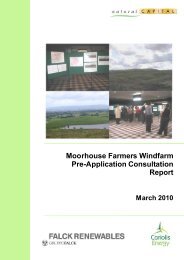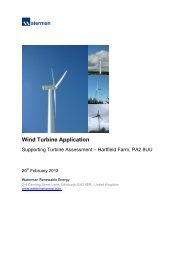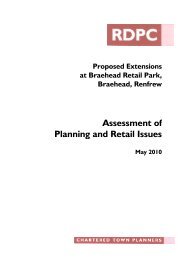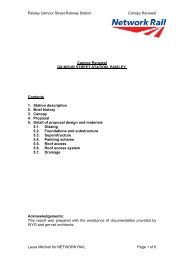GLENLORA WIND TURBINE - Renfrewshire Council
GLENLORA WIND TURBINE - Renfrewshire Council
GLENLORA WIND TURBINE - Renfrewshire Council
You also want an ePaper? Increase the reach of your titles
YUMPU automatically turns print PDFs into web optimized ePapers that Google loves.
© Green Cat Renewables Ltd<br />
<strong>GLENLORA</strong> <strong>WIND</strong> <strong>TURBINE</strong><br />
borrow pit and construction of access roads should be appraised as part of the overall<br />
impact of the scheme including impact on water and groundwater”.<br />
This NTS summarises the findings of the environmental studies that were undertaken<br />
to assess these potential effects.<br />
3.1 Climate Change<br />
There are two distinct aspects of wind turbine development that could have an<br />
impact on climate change:<br />
• Wind turbine manufacture, construction and decommissioning; and<br />
• Wind turbine operation.<br />
The wind turbine construction and decommissioning phases will lead to the emission<br />
of greenhouse gases, while the operation phase will offset greenhouse gases that<br />
would be emitted by generating the equivalent amount of energy via a conventional<br />
energy source. Thus, in assessing the overall impact of the project on climate<br />
change, the full lifecycle of the wind turbine are considered.<br />
Using guidelines from SNH, the climate change study for the proposed wind turbine<br />
concluded that the development would pay back CO2 in 2.6 months. The project will<br />
displace, year on year, CO2 produced through the UK generation mix and will provide<br />
a positive energy payback after life cycle considerations have been taken into<br />
account. Therefore, the turbine would have an overall positive effect in reducing UK<br />
greenhouse gas emissions.<br />
3.2 Local Economic Effect<br />
Every wind turbine in a rural area contributes to the farming economy with the<br />
provision of additional income and diversification of the rural economy. However, a<br />
project like this where the rural business (private estate) is the developer rather than<br />
simply a landlord, is an even greater benefit to the local economy.<br />
The wind turbine will provide an additional income stream for Glenlora Estate which<br />
will help offset fluctuations in the substantial energy costs incurred in the day to day<br />
running of the estate and also reduce the carbon footprint, thus improving the long<br />
term viability of a private estate which dates back to the 1900’s and securing jobs.<br />
The construction of the proposal would represent a moderate investment in the<br />
local area. The installed cost of a wind turbine of the capacity proposed is<br />
approximately £1,500,000. Of this sum, about 20% £300,000 would typically be<br />
spent in the locality of the project, with a range of contracts being placed with<br />
electrical and civil engineering companies to fencers and hoteliers.<br />
Once the wind turbine starts to supply electricity into the local electricity network,<br />
the landowner/developer directly involved in the project would benefit from<br />
reduced electricity bills and income from electricity sales payments, thus presenting<br />
Page 15 of 25<br />
Z:\projects\C0111-080 Glenlora\Planning\NTS\Glenlora NTS.doc
















